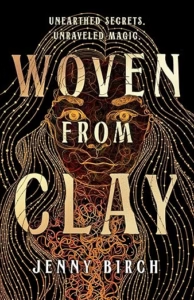Woven From Clay
Jenny Birch
Wednesday Books
Published August 12, 2025
Amazon | Bookshop | Goodreads
About Woven From Clay
In this fresh and imaginative contemporary fantasy, a golem must master the magic that binds her together and finds an unexpected ally in the mysterious boy sent to ensure her demise.
Terra Slater might not know anything about her birth family or where she comes from, but that’s never stopped her, and she fully intends her senior year to be her best yet. Until the dark and mysterious Thorne Wilder―a magical bounty hunter―moves to town, bringing revelations that wreck all of her plans.
When Terra learns she is a golem, not born but crafted from mud and magic by a warlock, her world is upended. Worse, Cyrus Quill, the warlock who made her, is a fugitive, on the run from the witches who want to hold him accountable for his past crimes. But Quill’s sentence is death, which would unravel the threads of magic that hold Terra―and all of the other golems that he crafted―together.
Desperate to save herself and her friends, Terra strikes a deal with Thorne and his coven to preserve the warlock’s life and his magic. If she can prove her worth to the coven by mastering the magic within her, the golems will survive. If she can’t, they’ll perish along with Cyrus. As Thorne helps her to see and manipulate the tapestry of magic that surrounds them, their unexpected alliance evolves into something more and Terra comes to understand the depths of her magic, her humanity, and her love for the people most important to her.
My Review
The book description makes it very clear that this is a contemporary fantasy, but I think I kept assuming from the cover that it was some kind of Greek myth retelling. I don’t know why. In any case, when I started reading the book, I was a little jolted by the present-day setting.
At first, it feels like a familiar tale. A girl facing an inexplicable problem meets a grouchy, emotionally-closed boy who’s new in town. There’s the inevitable tug of war over whether they’re on opposing sides or can trust a tentative alliance.
From there, we learn more about Thorne’s coven and the power dynamics at play. Terra experiments with her newfound ability, and Thorne becomes a lot more likeable.
The way the author uses names in the story is interesting. Once you know about Terra’s origin, it becomes easy to recognize the others who share a similar story. Some people might find that a bit heavy-handed, but I thought it was a neat idea.
The story definitely grew on me as I got into the history of Terra’s town and saw more of Thorne’s family. By the end, I was really invested in both Terra and Thorne.
If you enjoy paranormal romance or contemporary fantasy, I think this is a good one to pick up. It has a lot of similar vibes to the kinds of books coming out in the early 2000s, but without the problematic content.
Content Notes
Recommended for Ages 14 up.
Profanity/Crude Language Content
One instance of the f-bomb, and a sprinkling of other profanity. Not a huge amount.
Romance/Sexual Content
Kissing.
Spiritual Content
Witches live apart from humans in underground compounds where they use their magic according to the rules of their guild. Creating a golem is considered “warlock magic”, which is against their rules.
Violent Content
Situations of peril. If Terra’s creator dies, she and the other golems will perish as well. Someone tries to harm Terra’s friends, tripping them, sapping their energy, etc.
Drug Content
None.
Note: This post contains affiliate links, which do not cost you anything to use but help support this blog. I received a free copy of this book in exchange for my honest review. All opinions are my own.
